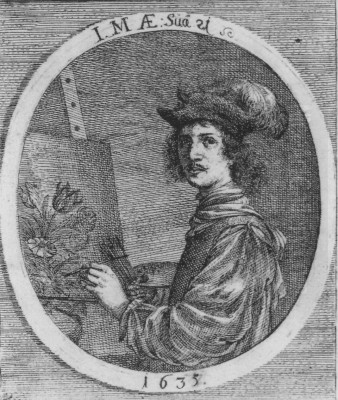
Jacob Marrel stands as a significant, albeit sometimes overlooked, figure bridging the German and Dutch traditions of still-life painting during the vibrant 17th century. Born in the German territories but spending crucial years in the Netherlands, Marrel became renowned for his exquisite depictions of flowers, particularly tulips, as well as insects and other naturalia. His life and work offer a fascinating window into the artistic exchanges, the burgeoning interest in the natural world, and the unique economic phenomena, like Tulip Mania, that characterized the Dutch Golden Age. Furthermore, his role extended beyond his own canvas; he was an influential teacher and an art dealer, shaping the careers of others, most notably his stepdaughter, the celebrated naturalist and artist Maria Sibylla Merian.
Early Life and Artistic Foundations in Germany
Jacob Marrel was born in 1613 or 1614 in Frankenthal, a town in the Palatinate region of Germany. His family, like many others at the time, faced religious upheaval, leading them to relocate. They initially moved to France before settling in the bustling city of Frankfurt am Main around 1624. Frankfurt was a major center for trade and publishing, fostering a climate where arts and sciences could flourish, despite the turbulence of the Thirty Years' War raging elsewhere. It was here that the young Marrel's artistic journey began in earnest.
Around 1627, Marrel became a student of Georg Flegel (1566–1638). This apprenticeship was formative. Flegel was one of the pioneers of pure still-life painting in Germany, known for his meticulously detailed compositions of meals, fruits, flowers, and small objects, often imbued with a quiet, contemplative atmosphere. Learning under Flegel provided Marrel with a strong foundation in the precise observation and rendering of textures, light, and form – skills that would become hallmarks of his own mature style. Flegel's influence can be seen in Marrel's early attention to detail and his ability to capture the specific characteristics of each object he painted.
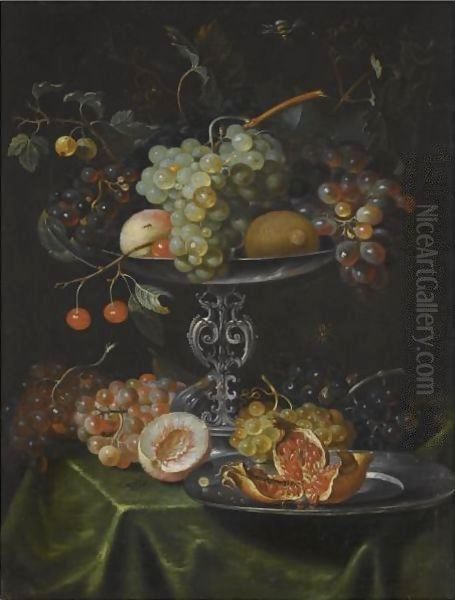
Frankfurt, with its established artistic community and connections to publishing houses like that of Matthäus Merian the Elder, provided a stimulating environment. Marrel absorbed the local traditions but soon looked towards the Netherlands, where still-life painting was reaching unprecedented heights of popularity and sophistication. This pull towards the Dutch artistic scene would significantly shape the next phase of his career.
The Utrecht Years: Immersion in the Dutch Still Life Tradition
Around 1630, Jacob Marrel made a pivotal move to Utrecht in the Dutch Republic. Utrecht was a major artistic hub, particularly renowned for its school of Caravaggisti painters earlier in the century, like Gerard van Honthorst and Hendrick ter Brugghen, but also a thriving center for still-life painting. This move immersed Marrel in the heart of the Dutch Golden Age art world, exposing him to new styles, techniques, and subject matter.
During his time in Utrecht, which lasted intermittently until about 1650, Marrel honed his skills, particularly in flower painting. He is known to have worked alongside or been significantly influenced by Jan Davidszoon de Heem (1606–1684), one of the most celebrated and versatile still-life painters of the era. De Heem, who worked in both Utrecht and Antwerp, was famed for his lavish and complex compositions, featuring flowers, fruits, and precious objects, executed with dazzling technical skill. Exposure to de Heem's work likely encouraged Marrel to develop richer compositions and a more vibrant palette compared to the somewhat more restrained style of Flegel.
Other prominent still-life painters were active in or associated with Utrecht around this time, contributing to a dynamic artistic milieu. Roelant Savery (1576–1639), though slightly earlier, had established a tradition of detailed flower paintings often including insects and lizards. Ambrosius Bosschaert the Elder (1573–1621) and his student and brother-in-law Balthasar van der Ast (1593/94–1657) were also key figures in the development of Dutch flower painting, known for their symmetrical compositions and botanical accuracy. Marrel’s work fits within this tradition, focusing on the beauty and diversity of the plant kingdom, rendered with scientific precision yet artistic flair.
The Allure of Tulips: Art, Commerce, and Tulip Mania
Jacob Marrel’s name is inextricably linked with tulips. His time in the Netherlands coincided with the peak and subsequent crash of "Tulip Mania" (roughly 1634-1637), a period when the prices of fashionable tulip bulbs reached extraordinary levels, only to collapse dramatically. While the speculative frenzy was relatively short-lived, the Dutch fascination with tulips endured, and these flowers remained highly prized status symbols and popular subjects for artists.
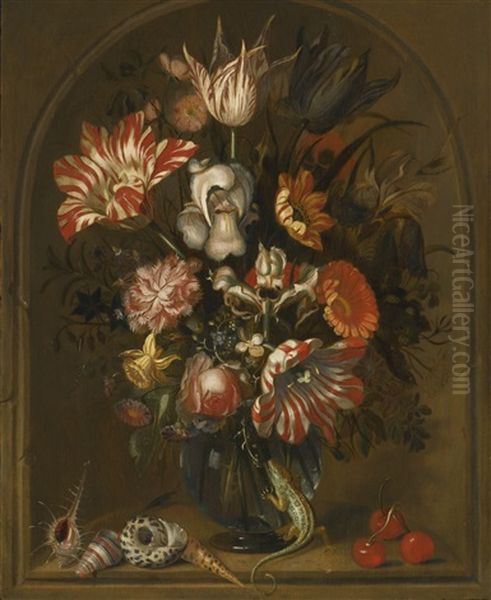
Marrel specialized in depicting tulips with remarkable accuracy and beauty. His paintings often feature rare and expensive varieties, showcasing their vibrant colors and intricate patterns, such as feathered or flamed petals caused by a virus (though the cause wasn't understood then). These paintings served multiple purposes: they were desirable luxury objects in themselves, celebrating the beauty of nature and the wealth of their owners, but they also functioned almost as catalogue illustrations for collectors and traders.
He produced at least six known "tulip books" – albums containing detailed watercolor illustrations of different tulip varieties, often accompanied by their names. These were highly valued by growers and merchants. Three of these precious books survive today, including a famous example housed in the Rijksmuseum in Amsterdam. These watercolors, executed on vellum or paper, demonstrate his mastery of the medium and his keen eye for botanical detail. They stand as important historical documents of the tulip trade and horticultural interests of the time.
One notable example of his work in this vein is the watercolor study Four Tulips. This work meticulously depicts four distinct varieties, identified by contemporary names: 'Boter man' (Butter man), 'Joncker' (Nobleman), 'Grote geplumaceerd' (Great plumed one), and 'Voorwint' (Tailwind). Each flower is rendered with individual character, showcasing the specific petal shapes and color patterns that made certain bulbs so coveted. Such works highlight Marrel's dual role as both artist and participant in the horticultural commerce of his day.
Return to Frankfurt: Master Painter and Influential Teacher
Although Marrel spent significant periods in Utrecht, he maintained strong ties to Frankfurt. He returned there around 1650 and established a successful studio. He took on apprentices, passing on the skills and knowledge he had acquired in both Germany and the Netherlands. His reputation attracted talented students eager to learn the art of still-life painting.
His most famous pupil was Abraham Mignon (1640–1679). Mignon, born in Frankfurt, began his training with Marrel around 1659. Recognizing his student's exceptional talent, Marrel took Mignon with him when he returned to Utrecht for a period around 1660. In Utrecht, Mignon likely continued his studies, possibly even working with Jan Davidszoon de Heem, further refining his technique. Mignon eventually became a highly successful still-life painter in his own right, known for his detailed and often complex compositions of flowers and fruits, sometimes set in outdoor grottos or niches, teeming with insects and small animals. His style, while deeply indebted to Marrel and de Heem, developed its own distinct character. Marrel's pride in his student is evident, and Mignon stands as a testament to Marrel's effectiveness as a teacher.
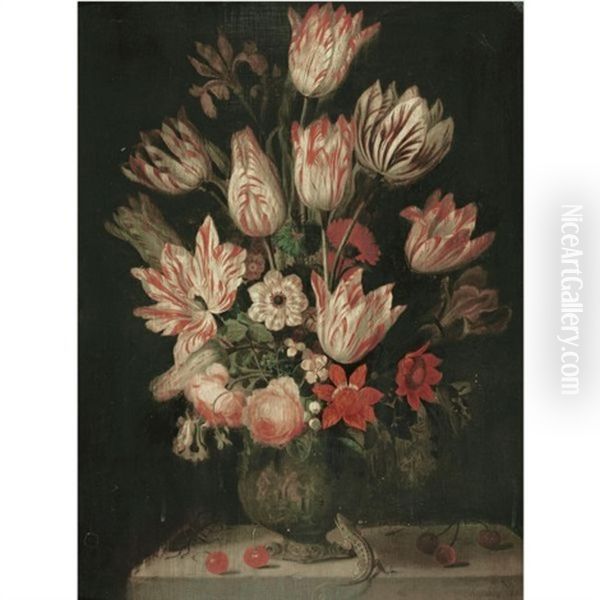
Marrel's activities were not limited to painting and teaching; he also operated as an art dealer. This was not uncommon for artists at the time, allowing them to supplement their income and stay connected with the broader art market. His knowledge of both German and Dutch art, combined with his connections in Frankfurt and Utrecht, would have positioned him well for this trade. This commercial aspect of his career further underscores the intersection of art and commerce that was so characteristic of the Dutch Golden Age.
Family Life: The Merian Connection
Jacob Marrel's personal life took a significant turn in 1651 when he married Johanna Sybilla Heim (or Haim). Johanna was the widow of the renowned Swiss-German engraver and publisher Matthäus Merian the Elder (1593–1650), who had established a major publishing house in Frankfurt. This marriage brought Marrel into a prominent and artistically inclined family. Matthäus Merian the Elder was famous for his detailed topographical engravings and maps, including the Topographia Germaniae.
Through this marriage, Jacob Marrel became the stepfather to Johanna's children from her marriage to Merian, including the young Maria Sibylla Merian (1647–1717). This relationship proved to be profoundly influential. Recognizing his stepdaughter's artistic talent and burgeoning interest in the natural world, particularly insects, Marrel took her under his wing and provided her with formal art instruction. He taught her drawing, watercolor, and oil painting techniques, focusing on the meticulous observation required for still life.
Marrel guided Maria Sibylla's early artistic development, encouraging her fascination with caterpillars, butterflies, and their metamorphosis – a subject largely unexplored in art and science at the time. He provided her with the technical skills needed to document her observations accurately and beautifully. This foundation was crucial for her later groundbreaking work as a naturalist and scientific illustrator. Maria Sibylla Merian would go on to publish seminal works like Metamorphosis Insectorum Surinamensium, based on her travels to Suriname, forever changing the fields of entomology and botanical illustration. Marrel's role as her first teacher was instrumental in setting her on this path. The Merian family connection also included Maria Sibylla's half-brother, Matthäus Merian the Younger (1621-1687), who was also a painter, primarily of portraits.
Artistic Style: Precision, Elegance, and Texture
Jacob Marrel's artistic style is characterized by precision, elegance, and a remarkable ability to render diverse textures. Working primarily in oil on panel or canvas, and watercolor on vellum or paper, he demonstrated a mastery inherited from Flegel and refined through exposure to Dutch masters like de Heem. His compositions are typically well-balanced, often featuring a central bouquet of flowers in a vase or a careful arrangement of objects on a ledge.
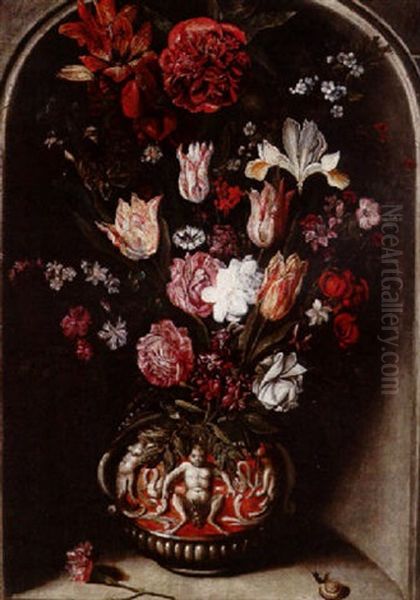
His flower paintings showcase a wide variety of species, often combining flowers that bloomed at different times of the year – a common convention in Dutch still life, aimed at creating an idealized image of nature's bounty. He captured the delicate translucency of tulip petals, the velvety softness of roses, and the intricate forms of irises and carnations. His palette is generally rich and vibrant, using color and light to create a sense of depth and realism. Light often falls strategically, highlighting key elements and creating subtle shadows that define form.
Beyond flowers, Marrel excelled at depicting other elements of the natural world. Insects – butterflies, beetles, caterpillars, flies – frequently appear in his paintings, rendered with entomological accuracy. These were not mere decorative additions; they often carried symbolic meanings (related to life, death, resurrection, or the transience of beauty) common in vanitas still lifes, although Marrel's work often emphasizes celebratory beauty over overt moralizing. He also painted fruit pieces, such as the work sometimes titled Grapes and Pomegranate, showcasing his skill in rendering the glossy skin of grapes, the jewel-like seeds of a pomegranate, and the reflective surfaces of accompanying metal or ceramic vessels. Occasionally, he included reptiles like lizards, adding an element of exoticism or perhaps further symbolic depth.
Compared to the starker arrangements of early German still life (Flegel) or the austere monochrome banquet pieces (ontbijtjes) popular in Haarlem (painted by artists like Pieter Claesz or Willem Claesz. Heda), Marrel's style aligns more closely with the colorful and often elaborate floral arrangements of Utrecht and Antwerp. However, his work generally retains a certain clarity and elegance, less opulent than the grand pronkstillevens (ostentatious still lifes) of artists like Willem Kalf, but richer than the earlier, more rigid bouquets of Bosschaert.
Network of Contemporaries and Influence
Jacob Marrel operated within a rich network of artists across Germany and the Netherlands. His primary teacher, Georg Flegel, connects him to the roots of German still life. His time in Utrecht placed him in the orbit of Jan Davidszoon de Heem, a dominant figure whose influence is palpable in Marrel's work. His own student, Abraham Mignon, carried forward the tradition, achieving considerable fame.
His connection to the Merian family through marriage linked him to Matthäus Merian the Elder, a major figure in European printmaking and publishing, and provided the context for nurturing the unique talent of Maria Sibylla Merian. This places Marrel at an interesting intersection of fine art painting, print culture, and the emerging field of scientific illustration.
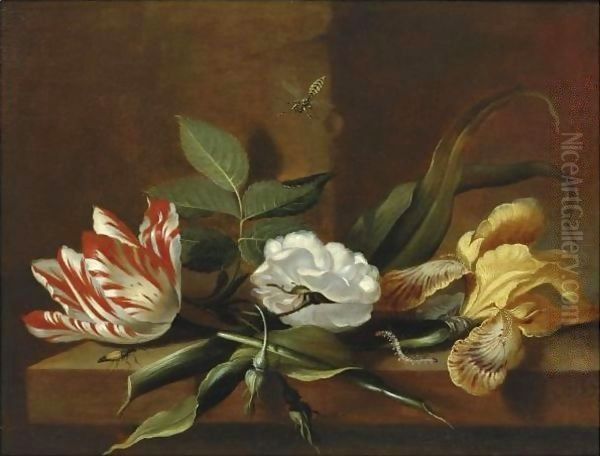
His work can be situated within the broader context of 17th-century still-life painting. He shared the Dutch fascination with detailed realism and the celebration of both natural and man-made objects. While flower painting was his specialty, the genre encompassed various sub-types. Artists like Rachel Ruysch (1664–1750) and Jan van Huysum (1682–1749), working slightly later, would bring Dutch flower painting to an even higher degree of refinement and complexity, building on the foundations laid by Marrel and his generation. Marrel's specific focus on tulips during Tulip Mania also gives his work a unique historical anchor, documenting a specific cultural and economic moment through art.
Later Life and Enduring Legacy
Jacob Marrel continued to work as an artist and likely as a dealer in his later years, possibly dividing his time between Frankfurt and the Netherlands. Historical records confirm his presence in Frankfurt for significant periods, including his marriage and the time he spent teaching Mignon and Merian. He passed away in Frankfurt am Main in 1681.
Jacob Marrel's legacy is multifaceted. As a painter, he produced a significant body of work characterized by technical skill, careful observation, and aesthetic appeal. His flower paintings, especially his tulips, are considered important examples of the genre and provide valuable insights into 17th-century horticulture and the phenomenon of Tulip Mania. His surviving tulip books are treasures of botanical art.
As a teacher, he played a crucial role in shaping the careers of Abraham Mignon, who became a leading still-life painter, and Maria Sibylla Merian, whose contributions to science and art were revolutionary. His influence extended beyond his immediate students, contributing to the cross-pollination of artistic ideas between Germany and the Netherlands.
He exemplifies the versatile artist of the period – skilled in multiple media (oil and watercolor), engaged in teaching, and active in the art trade. His life and work reflect the dynamism of the Dutch Golden Age, the growing European interest in the natural world, and the intricate connections between art, science, and commerce. Though perhaps not as universally famous as Rembrandt or Vermeer, or even the very top tier of still-life specialists like de Heem or Kalf, Jacob Marrel remains a key figure for understanding the richness and complexity of 17th-century European art. His paintings continue to be admired in museums and collections worldwide for their beauty, precision, and historical significance.